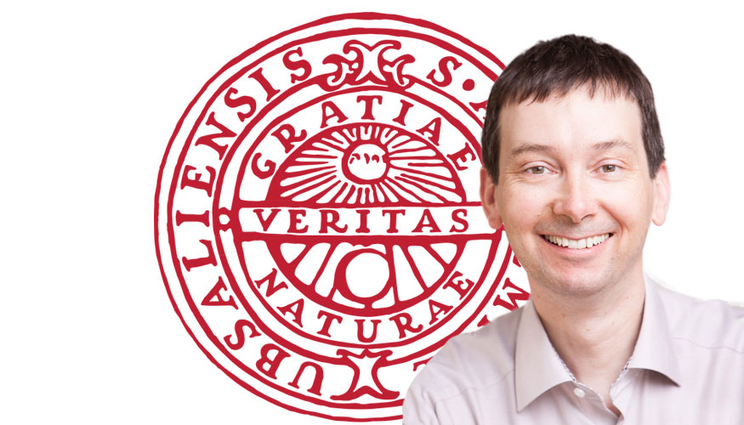Former LLNL physicist honored by Uppsala University for research with intense X-ray pulses
 (Download Image)
Henry Chapman, who worked at Lawrence Livermore National Laboratory from 1996 to 2007, will be presented with an honorary doctorate by Uppsala University for his work on developing techniques for imaging and crystallography with intense X-ray pulses.
(Download Image)
Henry Chapman, who worked at Lawrence Livermore National Laboratory from 1996 to 2007, will be presented with an honorary doctorate by Uppsala University for his work on developing techniques for imaging and crystallography with intense X-ray pulses.
Henry Chapman, who worked at Lawrence Livermore National Laboratory (LLNL) from 1996 to 2007, will be presented on Jan. 26 with an honorary doctorate by Sweden's Uppsala University for his work on developing techniques for imaging and crystallography with intense X-ray pulses.
In addition to lecturing as a professor of physics at Hamburg University, Chapman is the division director at the Center for Free-Electron Laser Science (CFEL) at the University of Hamburg and serves as the founding director of the Center for Free-Electron Laser Science at the German Electron Sychrotron (DESY).
During his time at LLNL, Chapman worked in a variety of subject areas, including extreme ultraviolet lithography (EUVL) projects that brought together three national labs -- Lawrence Livermore (LLNL), Sandia National Labs (SNL) and Lawrence Berkeley (LBNL) -- as well as private industry representatives, such as Intel, Motorola and others (EUVL has many industry applications in microelectronics). In these collaborations, Chapman proposed and developed a new method to align EUV optics. Groups he worked with on these projects won several directorate awards and garnered an R&D100 award for their project that put forth novel systems for microelectronics.
After his successful work in the area of EUVL, Chapman moved into imaging molecules with X-ray free-electron lasers (FELs). This was related to his previous work as a postdoctoral appointee at Stony Brook University, and involved in-depth collaboration with researchers working with the Linac Coherent Light Source (LCLS) at SLAC. Chapman and his fellow researchers received support from the National Science Foundation (NSF) Center for Biophotonics Science and Technology (CBST), and collaborated with researchers at Uppsala University and in Hamburg. This was the start of his work in Europe, which developed into full-time work at the University of Hamburg when he left the Lab in 2007. Before his departure, Chapman also was awarded the Edward Teller Fellowship for his work at LLNL.
Richard London, a fellow physicist who worked with Chapman during his time at LLNL when X-ray imaging facilities were starting to become a reality, said of Chapman’s work: "He started coming up with these really brilliant ideas about how you could look at things on the molecular scale, and once the opportunity came to us to really get going with X-ray imaging, he picked it up and ran with it. Henry was young at the time and came from a background that gave him unique expertise in this field, and he had a great energy to take the emerging capabilities and make the most of them. The group he left at the Lab has continued to work on this kind of imaging after he moved on to his work in Germany, and I think they were stimulated by the drive that Henry brought when he was here -- his passion for these kinds of experiments made a lasting mark on those who have continued them in his absence. He was a real pleasure to work with."
Since his departure from the Lab, Chapman has continued with his interest in molecular imaging with FELs and in 2009 led an international collaboration to carry out the first experiments in this area at LCLS, where a global team introduced a new technique now called serial femtosecond crystallography (SFX). "This has grown into a widely used technique for time-resolved protein structure studies and to look at structures of proteins that are notoriously difficult to work with," Chapman said. "I’ve also continued with efforts toward single-molecule imaging (to avoid the need for crystallization) and other ways to utilize intense X-ray pulses to gain structural information from biological samples."
The honorary doctorate from Uppsala University is being awarded for Chapman’s work in this field -- and not just his scientific breakthroughs, but also his initiatives to bring together and leverage international teams and resources. On being offered this distinction, Chapman said: "This work in FELs imaging has grown greatly in the number of people and organizations involved, with international consortiums and centers popping up around it -- but I find myself reminded that it all very much depends on the foundations that I and the teams at Lawrence Livermore started building more than a decade ago."
Contact
Maren Hunsberger[email protected]
19254226688
Related Links
Uppsala UniversityTags
Lasers and Optical S&TLasers
National Ignition Facility and Photon Science
Careers
Featured Articles







